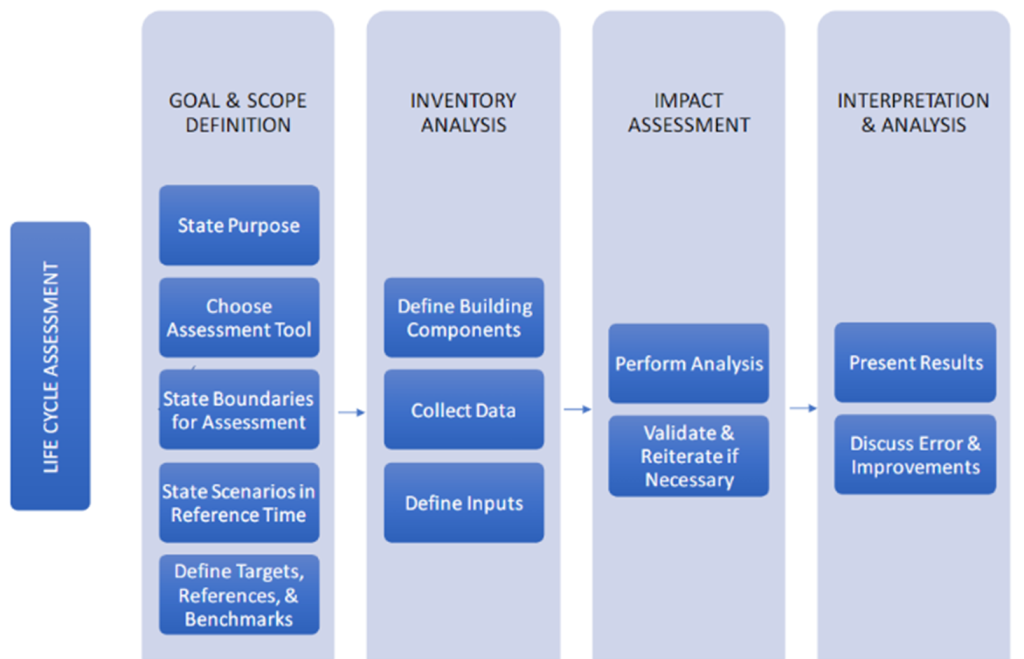Buildings are an essential part of our daily lives – we sleep in them, work in them, eat in them. But how do the buildings we live in impact the world around us? From unprocessed materials to initial construction to daily operations to eventual decommissioning, every phase of a building’s life produces environmental impacts. Life Cycle Assessment (LCA) is a modern tool for illuminating these impacts and making choices in design that will lead to a more sustainable and resilient structure.
What is a Life Cycle Assessment?
Life Cycle Assessment is a method for quantifying the environmental impacts of a product or process across its entire existence. Coca-Cola performed the first Life Cycle Assessment in the 1960s to evaluate the environmental impacts of its glass bottles, encompassing material extraction, transportation, product use, and disposal. Since then, Life Cycle Assessments have crossed sectors to influence buildings, not just bottles.
In the architecture, engineering, and construction industry, the LCA process involves four stages: (1) goal and scope definition, (2) inventory analysis, (3) impact assessment, and (4) interpretation and analysis.

The most widely used metric in Life Cycle Assessments for buildings is global warming potential (i.e., the CO2 equivalent released into the atmosphere as a result of the building project). It is often abbreviated as GWP. Other metrics in LCAs include acidification, eutrophication, ozone depletion, and smog formation potentials. Products such as Tally, Athena, and One Click make performing an LCA more manageable by maintaining life cycle inventories of products and, in some cases, integrating with modeling programs (e.g., REVIT). The assessment evaluates raw material extraction, processing of raw materials into construction products, transportation to the site, building use, deconstruction, and material disposal or recycling/reuse.
Why Perform a Life Cycle Assessment?
A Life Cycle Assessment performed early in a building’s design can help:
Inform Structural System and Building Materials Selection. The environmental impact of studied systems and materials are quantitatively provided by LCA. This can, in turn, provide confidence to designers and owners as they optimize design and assess the merits of each system or material. Furthermore, prioritizing low environmental impacts is an emerging trend, leading to advancement and innovation within the AEC community.
Achieve Sustainability Certification. Performing a Life Cycle Assessment can earn points toward LEED certification, International Living Future Institute certification, or other green building initiatives. For building owners who value sustainability certification, particularly where global warming potential is a criterion, an LCA is essential.
Identify Opportunities for Improvement or Efficiencies. Explicit consideration of environmental impacts has led to innovative building systems and methods. The rise in construction of mass timber buildings has grown synergistically with the rise in acknowledgement of the global warming potential contributed by building construction. Similarly, the development of low-carbon concrete technologies has rapidly expanded in response to concerns expressed by design teams over the contribution to global warming potential from Ordinary Portland Cement. An LCA provides the critical opportunity to better understand a project’s sustainability impact and thereby explicitly target the use of innovative solutions.
Utah Case Study
For a recent multifamily development in Utah, the owner wanted to compare costs and benefits between an all-steel structural system and a steel-timber hybrid system.
KPFF performed a high-level Life Cycle Assessment, focusing on embodied carbon (or global warming potential) and embodied energy (or energy depletion potential). The study found that the global warming potential and energy depletion potentials were approximately 70% and 50% lower, respectively, in the hybrid structural system when compared with the all-steel system. The decreased environmental impacts were due to the significant amount of carbon sequestered within lumber products (known as biogenic carbon) and the low energy associated with producing mass timber products.
Additionally, KPFF explicitly considered the architectural floor assembly within an improved LCA study. The floor assemblies in the study were unique because the project was targeting high sound transmission class ratings. Including the floor assembly, which varied between structural systems, allowed a more wholistic analysis to be conducted. When including both architectural floor assembly and structural system, the study found that the global warming potential and energy depletion potential were approximately 10% and 30% lower for the hybrid system when compared with the all-steel system. These results, when compared to the structural system only results, reflect the importance of a wholistic approach to LCA. These rapid LCAs took less than a week to return to the owner and provided them with critical, quantitative information on the environmental impacts to consider along with cost and other factors.
Regardless of project type or size, a Life Cycle Assessment is a valuable tool for evaluating the impact of buildings throughout their lifespan. By informing design decisions, Life Cycle Assessments can help owners and design teams select appropriate building materials, achieve project sustainability goals, and identify opportunities for innovation. As the construction industry continues to prioritize sustainability, Life Cycle Assessments will become increasingly important for designing and constructing buildings that not only give us spaces to live, work, and play, but preserve our planet for decades to come.
To learn more about KPFF’s commitment to sustainability and environmental stewardship, click here.
[Cover Image: Julia West Apartments; rendering courtesy of Holst Architecture]



